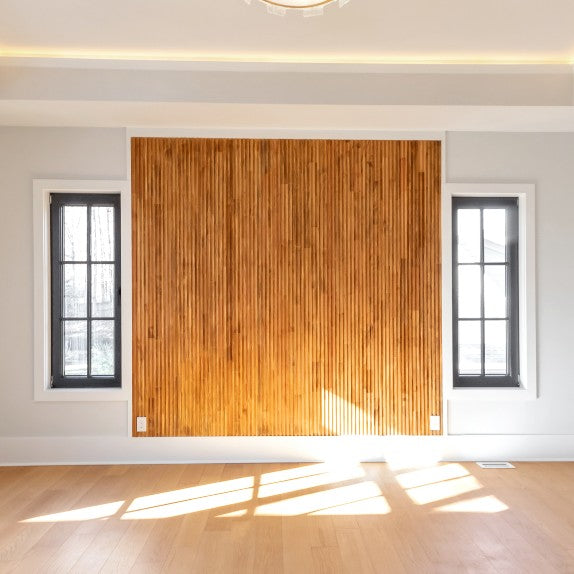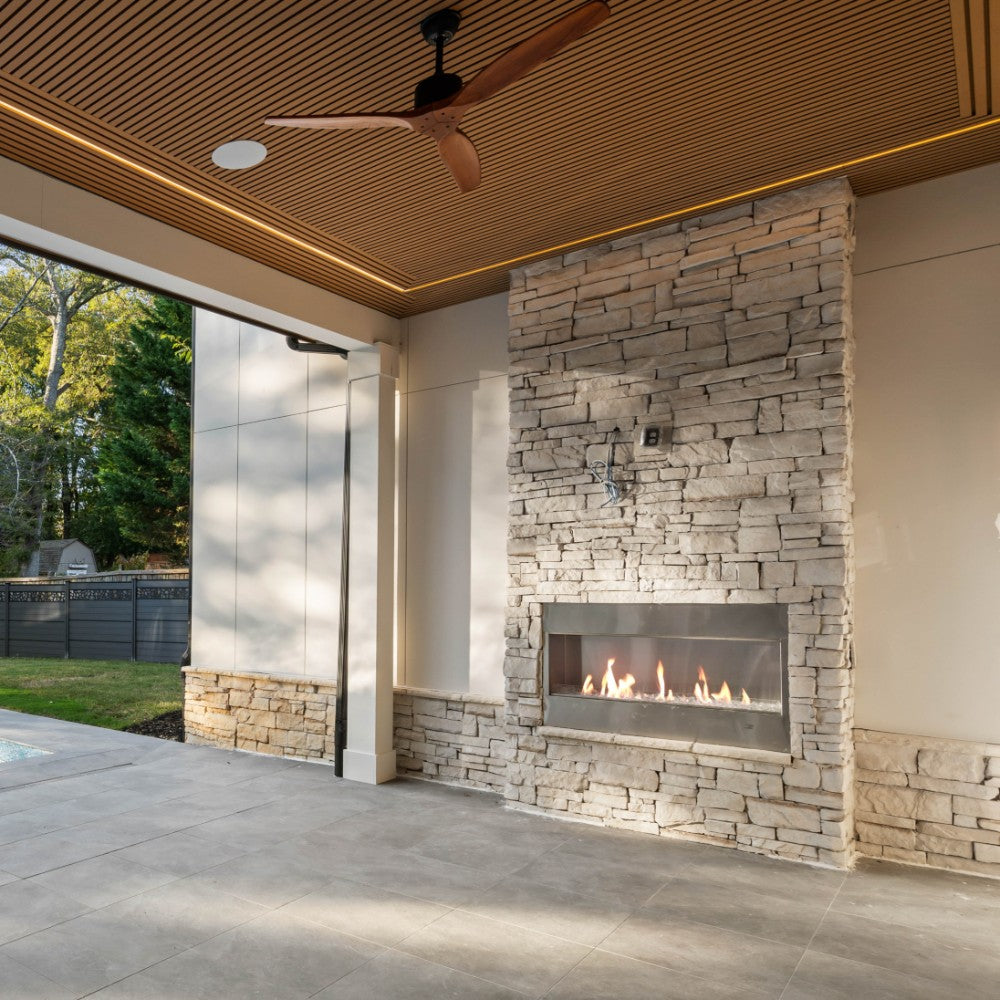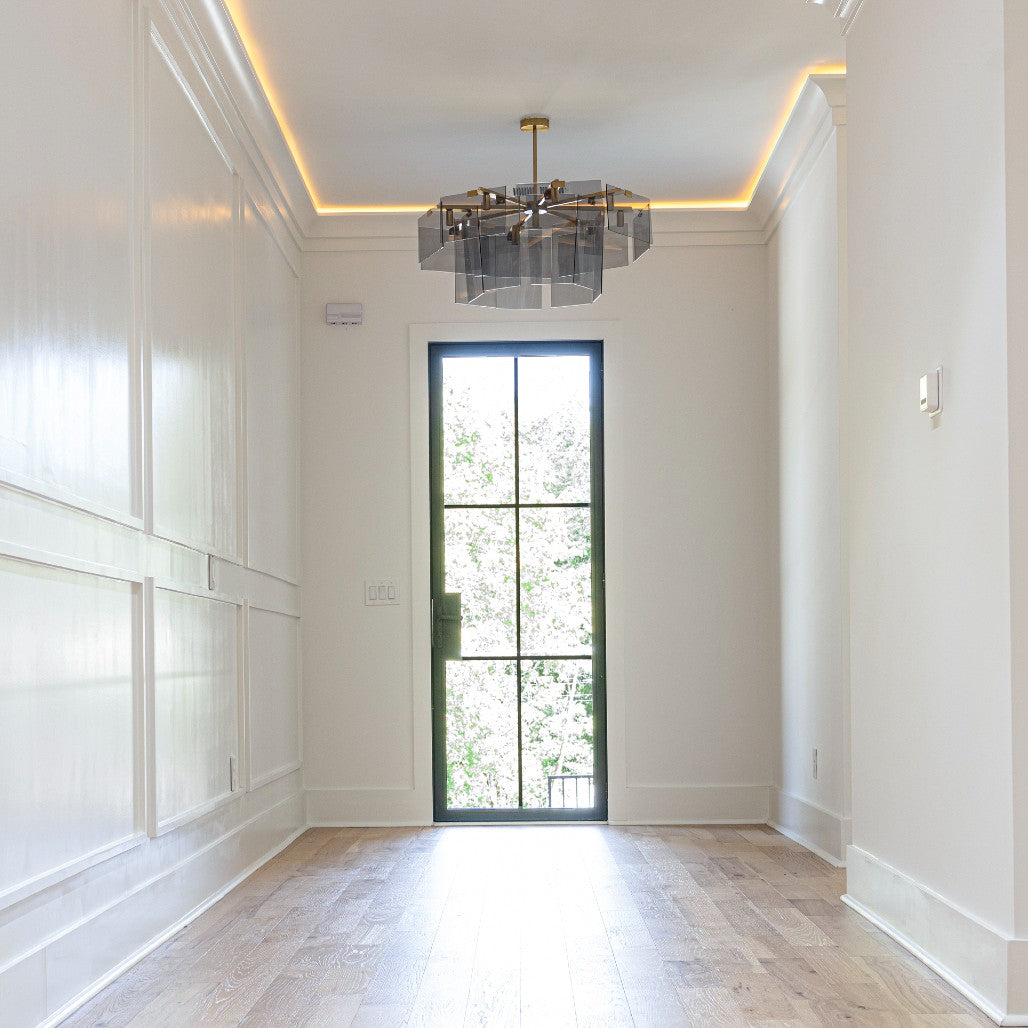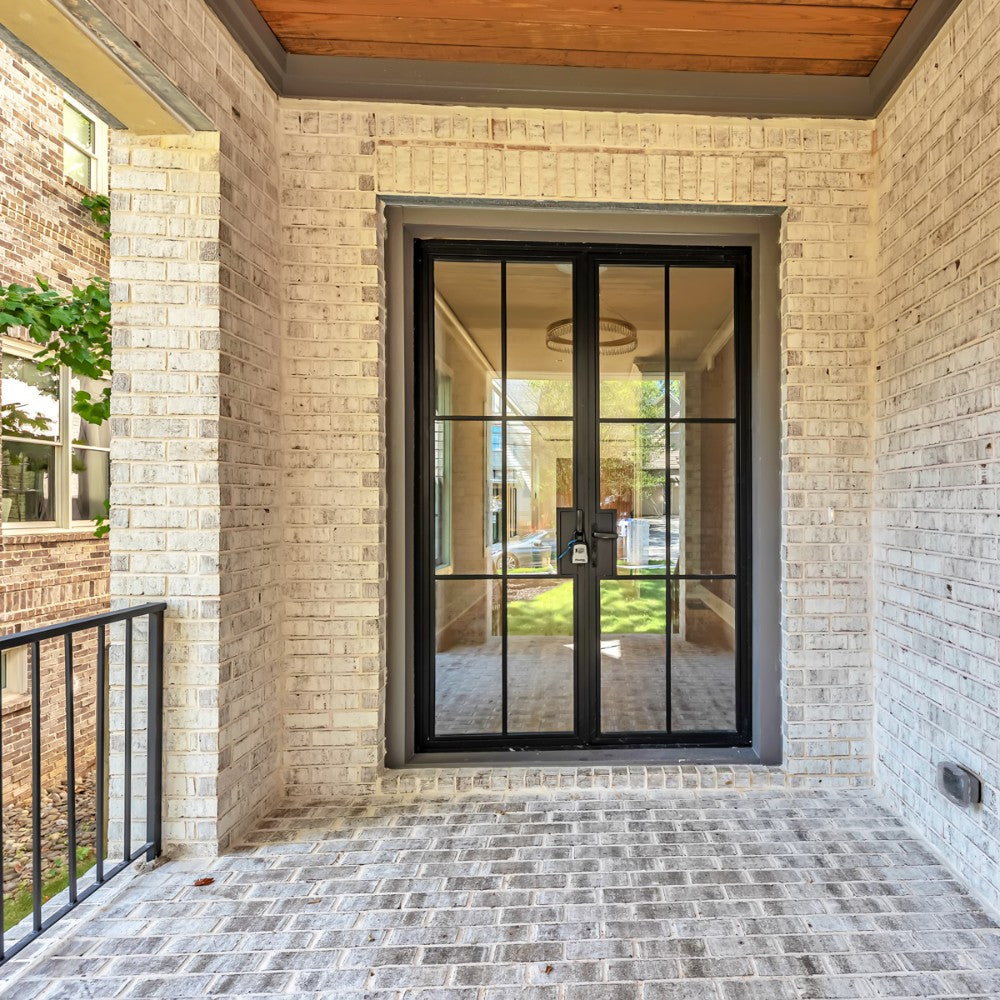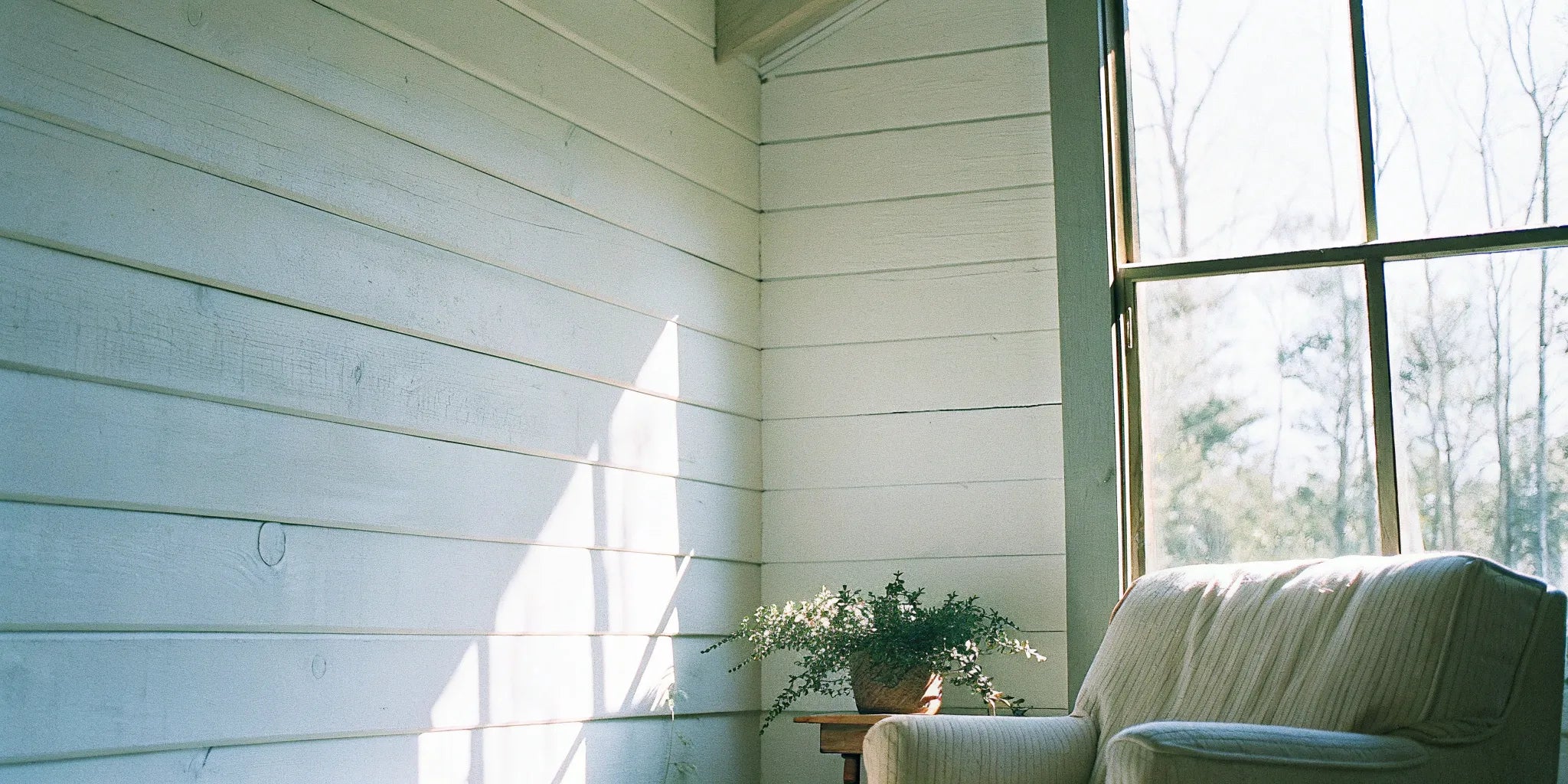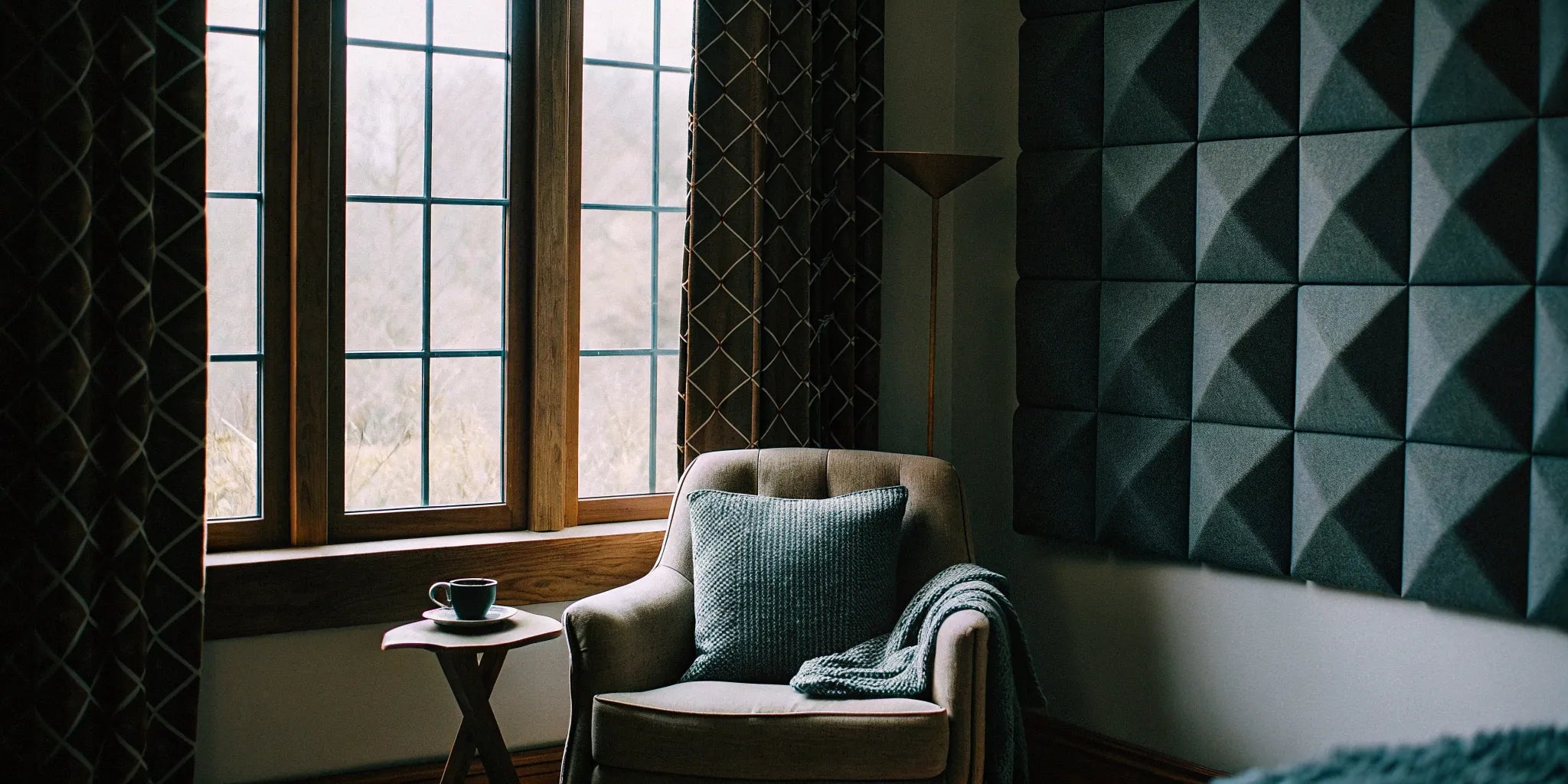
7 Best Acoustic Panels for Your Home or Studio
Acoustic treatment used to mean choosing between style and function. Thankfully, those days are over. Today’s acoustic panels are a powerful design tool, improving a room's aesthetic while making it sound incredible. Forget boring foam squares. Think elegant wood slat panels, fabric-wrapped art pieces, and finishes that blend right into your walls. This guide is all about integrating sound control seamlessly into your design. We’ll cover the different types, explain what performance ratings actually mean, and share our top picks for the best acoustic panels for your space.
Key Takeaways
- Panels absorb echo, they don't soundproof your room: Their job is to improve sound quality inside a space by stopping sound waves from bouncing off hard surfaces. For the biggest impact, install them at the room's first reflection points.
- Check the NRC rating for real performance: This number is the clearest indicator of how well a panel absorbs sound. Aim for an NRC of 0.7 or higher and choose panels made from dense materials like fiberglass over lightweight foam for better results.
- Decide between DIY customization and professional convenience: Building your own panels can save money and allows for a perfect fit, while buying professionally made panels guarantees performance with certified NRC and fire safety ratings right out of the box.
What Are Acoustic Panels (And Why Do You Need Them)?
Ever been in a room where conversations feel loud and chaotic, or the sound from your TV echoes just enough to be annoying? That’s usually because of poor room acoustics. Hard surfaces like drywall, hardwood floors, and large windows are notorious for bouncing sound waves all over the place, creating reverb and flutter echo. This is where acoustic panels come in. They are specially designed panels you mount on walls or ceilings to absorb sound, control echoes, and make a space sound clearer and more pleasant.
Whether you’re setting up a home theater, trying to focus in a home office, or designing a quiet living area, acoustic wall panels are a game-changer. They don’t just improve the sound quality for entertainment; they can make any room feel more comfortable and serene by taming unwanted noise. Think of them as a functional design element that serves a very practical purpose: making your space sound as good as it looks.
How Do Acoustic Panels Actually Work?
At its core, an acoustic panel’s job is to stop sound from bouncing around. When sound waves hit a hard surface, they reflect off it and continue traveling through the room. Too much reflection creates that echoey, muddled sound. Acoustic panels are made from soft, porous materials that do the opposite. Instead of reflecting sound, they soak it up.
When a sound wave hits the panel, it travels into the absorptive material, and its energy is converted into a tiny amount of heat. This process effectively traps the sound, preventing it from bouncing back into the room. The result is less echo and reverb, which leads to much clearer, more defined sound. It’s an essential fix for home studios, conference rooms, or any space where you need to control sound quality.
A Quick Guide to Acoustic Panel Types
Not all acoustic panels are created equal; they’re designed for different jobs. Understanding the main types will help you choose the right solution for your room.
- Absorbent Panels: These are the most common type and what most people picture. They are designed to absorb sound waves across a broad range of frequencies, making them perfect for reducing general echo and reverb in offices, living rooms, and home theaters.
- Diffuser Panels: Instead of absorbing sound, diffusers scatter it in different directions. This breaks up strong reflections without making the room sound completely “dead.” They help create a more balanced and natural acoustic environment, which is often preferred in listening rooms or performance spaces.
- Bass Traps: These are specialized absorbent panels designed specifically to tackle low-frequency sound waves (bass). Bass tends to build up in the corners of a room, making music or movies sound boomy and unclear. Bass traps are thicker and denser to effectively absorb that powerful low-end energy.
Acoustic Panels vs. Soundproofing Panels
This is one of the biggest points of confusion, so let’s clear it up: acoustic panels are for sound treatment, not soundproofing. Think of it this way: acoustic treatment handles the sound quality inside a room, while soundproofing stops sound from getting in or out. An acoustic panel acts like a sponge, soaking up echoes and reverb to make a space sound clearer. Soundproofing, on the other hand, is like a solid barrier designed to block sound from traveling between rooms. So, if your goal is to stop hearing your neighbor’s TV, you need soundproofing. If you want your home theater to sound crisp and clear without annoying echoes, you need acoustic treatment.
Specialty Acoustic Panels
The world of acoustic treatment has expanded far beyond simple fabric-covered squares. Today, you can find specialty panels that are as much a design statement as they are a functional tool. For instance, wood slat acoustic panels have become incredibly popular for their ability to add warmth and texture to a room while effectively taming echoes with their felt backing. You can also find paintable panels that blend seamlessly into your wall for a minimalist look. For projects that require extra durability or a specific aesthetic, options like Interior WPC (Wood Plastic Composite) fluted panels offer a modern, resilient solution. These specialty options prove you don’t have to choose between great sound and great style.
Common Myths, Busted
There’s a lot of confusion about what acoustic panels can and can’t do. Let’s clear up a couple of common myths so you can set realistic expectations for your project.
First, many people believe a few panels can fix the acoustics in a large room. The truth is, effective acoustic treatment requires strategic placement and sufficient coverage. A couple of panels on one wall in a big, empty room won’t make a noticeable difference. The size of the room and the amount of reflective surfaces determine how many panels you’ll need.
Another huge misconception is that acoustic panels can soundproof a room. Acoustic panels are designed to improve the sound inside a room, not block sound from entering or leaving it. Soundproofing requires dense, heavy materials to create a barrier. Since acoustic panels are lightweight and porous, they won’t stop your neighbor’s music from coming through the wall.
Our Top Picks for the Best Acoustic Panels
Finding the right acoustic panels can feel overwhelming, but it doesn't have to be. I've sorted through the options to bring you a list of the best panels out there, whether you're a contractor outfitting an office or a homeowner creating a peaceful sanctuary. We'll look at everything from professional-grade solutions to stylish, budget-friendly picks. Each of these options brings something unique to the table, so you can find the perfect match for your room's needs and your personal style. Let's get into the top contenders that will help you control sound and create a more comfortable space.
USA Builders Depot Premium Acoustic Panels
When you need a reliable, effective, and straightforward solution, our own Acoustic Wall Panels are the perfect starting point. Designed for both residential and commercial projects, they deliver excellent sound absorption without breaking the bank. We focus on providing high-quality materials that are easy to install, making them a favorite among contractors and DIY enthusiasts alike. Whether you're quieting a home office, a conference room, or a living area, these panels offer a clean look and dependable performance. They are an ideal choice for anyone looking for a balance of affordability and quality from a supplier they can trust.
GIK Acoustics Professional Series
If you’re serious about sound, GIK Acoustics is a name you’ll hear often. Their panels are a top recommendation among audiophiles and sound engineers for a reason. They deliver professional-grade sound absorption that can transform a home theater or recording studio. While they might be more of an investment, their performance is undeniable. Community discussions often highlight GIK for their exceptional build quality and effectiveness in treating a room's specific acoustic problems. For those who prioritize pristine audio, these panels are considered one of the best choices available.
Primacoustic London Series
Worried about damaging your walls? The Primacoustic London Series is your answer. These panels are incredibly lightweight, which means you can often hang them with simple 3M strips instead of drilling holes. This makes them a fantastic option for renters or anyone who likes to change up their decor without a lot of fuss. They strike a great balance between looking good and performing well, offering a clean, modern aesthetic that fits into almost any space. If you need an effective acoustic solution that’s easy to install and gentle on your walls, Primacoustic is a smart pick.
ATS Acoustic Panels
For a panel that puts safety and performance first, look no further than ATS Acoustics. Their panels are often praised as a top choice for professional sound treatment because of their high-quality, fire-resistant fabric. What’s great is that they achieve this fire rating without using harsh chemicals, making them a safer choice for homes, schools, and offices. The craftsmanship is excellent, ensuring they not only absorb sound effectively but also stand the test of time. If you need a durable, safe, and high-performing panel, ATS is a brand that consistently delivers.
Dekiru Sound Absorption Panels
If you're looking for a stylish and budget-friendly option, the Dekiru panels are a standout. Often highlighted as an "Editor's Pick" for their design, these thin panels come in various colors to match your decor. They are perfect for gaming setups, home offices, or creative studios where aesthetics matter just as much as sound control. With a reported Noise Reduction Coefficient (NRC) of 0.92, they are surprisingly effective at absorbing sound, making them a powerful and affordable choice for smaller spaces that need a modern touch.
Art3d Designer Panels
Who says acoustic panels can't be a design statement? The Art3d Wood Slat panels prove they can. These panels merge contemporary style with acoustic function, mimicking the look of high-end wood slat walls while quietly absorbing unwanted noise. They are an excellent choice when you want to integrate sound control seamlessly into your interior design. Instead of looking like a technical add-on, they become part of the room's architecture. For anyone wanting to create a modern, sophisticated space without compromising on sound quality, these designer panels are a perfect fit.
Acoustimac DMD Panels
Everyone loves a good deal, and Acoustimac is a great place to find one. They frequently offer their high-quality DMD Acoustic Panels on clearance, allowing you to get premium sound absorption for a fraction of the price. This is an excellent opportunity for anyone working with a tight budget to invest in panels that truly perform. While the selection might be limited to specific sizes or colors, the savings are significant. If you’re patient and check back often, you can outfit your space with top-tier acoustic treatment without the premium price tag.
How to Choose the Right Acoustic Panel
Shopping for acoustic panels can feel a bit technical, but you don't need an engineering degree to make a great choice. Once you know a few key features, you can confidently pick panels that will quiet your space and look great doing it. Think of it like buying any other material for your home or project—it’s all about matching the right product to your specific needs. From performance ratings to the materials they’re made of, here’s a straightforward guide to what really matters when you’re comparing options.
What's a Good NRC Rating?
The Noise Reduction Coefficient (NRC) is a simple rating that tells you how much sound a panel can absorb. It’s a number between 0 and 1—the closer to 1, the more sound it soaks up. For a noticeable difference in a room, you’ll want to find panels with an NRC of 0.7 or higher. If you’re dealing with significant noise issues in a home theater or studio, aiming for 0.8 or more is a smart move. This single number is one of the quickest ways to gauge a panel’s performance before you buy.
Understanding Key Performance Metrics
While the NRC rating gives you a great snapshot of a panel's absorption power, a couple of other terms can help you understand the real-world impact of acoustic treatment. You don't need to be a sound engineer, but knowing about decibel reduction and reverberation time will give you a clearer picture of what you're trying to achieve. These metrics move beyond a simple number and get into how a room actually feels and sounds once the panels are installed. Think of them as the "before and after" measurements that show just how much of a difference the right panels can make.
Decibel (dB) Reduction Explained
Decibel (dB) reduction is simply a measure of how much quieter a room gets. When you install effective acoustic panels, they absorb sound that would otherwise bounce around, which helps lower the overall noise level. This is what makes conversations easier to understand and gets rid of that distracting echo. It’s important to remember this is about improving the sound quality within the room. As we've covered, acoustic panels aren't for soundproofing—they won't block your neighbor's dog from barking. Instead, they create a more controlled and pleasant acoustic environment by reducing the intensity of sound reflections inside your space.
What is Reverberation Time (RT60)?
Reverberation Time, often called RT60, is the time it takes for a sound to completely fade away in a room. In a space with lots of hard surfaces like a gymnasium, the RT60 is long, which is why it sounds so echoey. In a well-treated recording studio, the RT60 is very short, making sounds crisp and clear. For most projects, the goal is to reduce this time so that speech is intelligible and music sounds clean. Professionals use RT60 calculations to determine exactly how much acoustic material a room needs to achieve a desired sound. While you might not run these calculations yourself, understanding the concept helps you appreciate why proper coverage is so important for taming an echoey room.
What Are the Best Materials for Acoustic Panels?
The stuff inside the panel is what does all the work. Common materials include dense fiberglass, mineral wool (like Rockwool), and acoustic foam. While foam panels are often cheaper, they typically don't perform as well as panels made from fabric-wrapped fiberglass or mineral wool. These denser materials are simply better at trapping sound waves. High-quality Acoustic Wall Panels are built to last and provide consistent sound absorption, so investing in good materials from the start pays off in the long run.
Does Thickness and Density Really Matter?
Just like with insulation, the thickness and density of an acoustic panel determine what kind of sound it’s best at absorbing. If you’re trying to tame low-frequency sounds like the bass from a sound system or traffic rumble, you’ll need thicker panels—think two inches or more. For higher-frequency sounds like chatter, echoes, and keyboard clicks, thinner panels around one to two inches will do the job perfectly. Matching the panel’s thickness to your specific noise problem is key to getting the results you want.
Why Panel Thickness is Crucial
Think of it this way: low-frequency sound waves, like the deep rumble from a movie or the bass in a song, are long and powerful. To stop them, you need a panel with enough depth to absorb that energy. This is why thicker panels, especially those over two inches, are essential for treating rooms with significant bass issues. A thin, one-inch panel simply doesn't have the mass to effectively absorb low-frequency sound. While thinner panels can help with high-frequency flutter echo from conversations, a panel that's at least three to four inches thick will give you much better performance across the entire sound spectrum, making it a smarter investment for almost any application.
Why You Can't Ignore Fire Safety Ratings
Since you’re adding new material to your walls, it’s crucial to make sure it’s safe. Fire ratings tell you how a material reacts to fire. Always check for a fire safety rating before you purchase. The gold standard is a Class A fire rating, which means the material is highly resistant to flame spread. This is an absolute must for commercial projects and a very smart choice for any home. You can usually find this information on the product’s spec sheet or by asking the supplier directly.
Finding Panels That Match Your Vibe
Acoustic panels aren’t just functional—they’re part of your room’s design. Gone are the days of boring, gray foam squares. Today, you can find panels that look like art, wood slats, or are wrapped in beautiful fabrics. Think about how you want the panels to contribute to the room's aesthetic. You can make them a bold statement piece or choose a finish that blends seamlessly with your walls. Options like Unfinished Wood Wall Panels can even be painted or stained to perfectly match your decor.
Should You DIY or Buy Your Acoustic Panels?
Deciding between making your own acoustic panels and buying them ready-made is a big question for any soundproofing project. There’s no single right answer—it really comes down to your budget, your timeline, and how much you enjoy a good weekend project. The DIY path gives you total control over size and appearance, and it can be incredibly rewarding to see your own handiwork improve your room’s sound. Many people find that building their own panels is not only cheaper but can also yield fantastic results, sometimes even better than off-the-shelf options.
On the other hand, buying professional panels offers convenience and guaranteed performance. You get a product that’s been tested, rated, and engineered for optimal sound absorption right out of the box. This route saves you time and eliminates the guesswork, which is a huge plus if you’re managing a larger renovation or simply want a polished, reliable solution without the sawdust. Think about what matters most to you: Is it saving money and getting a custom fit, or is it saving time and getting a proven, professional-grade product? Your answer will point you in the right direction.
How to Build Your Own Acoustic Panels
If you’re comfortable with basic tools, building your own acoustic panels is a completely achievable project. The biggest draw is customization. You get to choose the exact dimensions to fit your space perfectly and select a fabric that matches your decor, from neutral linens to bold patterns. Many home theater enthusiasts and musicians go this route because a well-constructed DIY panel, made with thick, dense insulation, can often absorb sound more effectively than many thin, commercially available alternatives. It’s a fantastic way to get high-performance results on a budget, as long as you’re willing to put in the time and effort to get the details right.
Essential Safety Precautions
When you’re building your own panels, safety should always come first. You’re working with materials that will become a permanent part of your room, so it’s important to get this right. The most critical factor is fire safety. Always check for a fire safety rating before you purchase materials. The gold standard is a Class A fire rating, which means the material is highly resistant to flame spread. This is an absolute must for commercial projects and a very smart choice for any home. Also, remember to protect yourself during the building process. Insulation materials like fiberglass or mineral wool can irritate your skin and lungs, so wear gloves, a mask, and long sleeves while you work.
Choosing the Right Acoustic Fabric
The fabric you choose does more than just make your panels look good; it has to be acoustically transparent. This means sound waves need to pass through it easily to reach the absorptive core inside. A simple way to test this is the “breath test”—if you can breathe through the fabric without much resistance, it’s a good candidate. Burlap, muslin, and special speaker grille cloth are all popular choices. Acoustic panels aren’t just functional—they’re part of your room’s design. You can choose a fabric that blends in or a bold pattern that makes a statement. For a different aesthetic, you could even use Unfinished Wood Wall Panels that can be stained or painted to match your decor perfectly.
Creative Low-Cost DIY Alternatives
If building panels from scratch still feels like too much, there are other creative ways to improve your room’s acoustics on a tight budget. Heavy moving blankets hung on walls can be surprisingly effective at taming high-frequency echo—it’s a classic trick used in temporary recording spaces. Don’t underestimate the power of soft furnishings, either. Thick rugs, heavy curtains, and even a well-stocked bookshelf can absorb a significant amount of sound. Many people find that building their own solutions is not only cheaper but can also yield fantastic results. Getting creative with materials you already have can make a big difference without a big investment.
Which is Cheaper: DIY or Pro Panels?
Let’s talk numbers. The main reason people choose to build their own acoustic panels is to save money. When you buy the raw materials—insulation, lumber for the frame, and fabric—the cost per panel is significantly lower than buying a pre-assembled one. However, don't forget to factor in the "hidden" costs. If you don't already own a saw, a good staple gun, and other basic tools, you'll need to purchase them. Your time is also valuable, so consider how many hours you'll spend measuring, cutting, and assembling. For many, the savings are well worth the effort, but it’s smart to price out your materials beforehand to get a clear picture of the total investment.
Your DIY Acoustic Panel Shopping List
Ready to build your own panels? The shopping list is surprisingly simple. The core of your panel will be a sound-absorbing material, with ROCKWOOL or Owens Corning fiberglass insulation being the most popular choices for their excellent performance. You’ll need to build a simple wooden frame to house the insulation, typically using 1x3 or 1x4 planks. Finally, you’ll wrap the entire panel in a breathable fabric—muslin, burlap, or duck cloth are great, affordable options. Just make sure air can pass through it easily. Your essential tools will include a saw for cutting the wood, a heavy-duty staple gun for attaching the fabric, a measuring tape, and a square to keep your corners true.
Why Go with a Professional?
While the DIY route has its perks, there are compelling reasons to opt for professionally made panels. First and foremost is the guaranteed performance. Reputable manufacturers provide a Noise Reduction Coefficient (NRC) rating, so you know exactly how effective the panel will be at absorbing sound. This takes all the guesswork out of the equation. Professional Acoustic Wall Panels are also built for durability and often come with fire safety ratings, which is a critical consideration for commercial spaces and homes alike. If you’re short on time or want a flawless, high-end finish without the hassle, investing in a professional solution is often the smartest choice for achieving superior, reliable sound control.
How to Place Acoustic Panels for the Best Sound
Once you’ve chosen your acoustic panels, the next step is getting them on the walls. Proper placement is just as important as the quality of the panels themselves. Think of it like this: you wouldn’t put a speaker in a closet and expect it to fill a room with sound. The same logic applies here. Placing panels strategically ensures you get the maximum sound-absorbing benefit, turning a chaotic, echo-filled room into a calm, clear space. Let’s walk through the process step-by-step to make sure you get it right.
How to Assess Your Room's Acoustics
Before you even think about grabbing a drill, take a good look at your space. What is the room used for? A home office has different sound needs than a home theater or a recording studio. Consider the room’s size and shape, as well as the materials already in it. Hard surfaces like hardwood floors, large windows, and bare walls reflect sound, creating more echo and reverberation. Softer surfaces like carpets, curtains, and upholstered furniture absorb it. Understanding your room’s current acoustic profile will help you identify the problem areas and decide where acoustic wall panels will make the biggest impact.
Where Should You Place Acoustic Panels?
The most effective way to place acoustic panels is by targeting the first reflection points. These are the spots on your walls and ceiling where sound waves bounce directly off a surface before reaching your ears. An easy way to find them is with the “mirror trick.” Sit in your primary listening position (like your desk chair or the center of your couch) and have a friend slide a small mirror along the walls. Anywhere you can see the sound source (like your speakers or your TV) in the mirror is a first reflection point. Mark these spots—this is where your panels will do the most good to tame echoes and improve sound clarity.
Placement Strategies for Different Rooms
The best placement for your panels really depends on what you do in the room. In a home theater, your goal is pristine audio, so you’ll focus on the first reflection points on the side walls, ceiling, and the wall behind your speakers to create a controlled listening environment. For a home office, the priority is clear communication. Placing panels on the wall behind you can absorb voice echoes during video calls, while treating the wall opposite your desk can cut down on distracting reverberation. In a large, open-concept living area, the aim is often to reduce overall noise and create a more peaceful atmosphere. Here, you might focus on treating large, parallel walls to stop flutter echo in its tracks. Each space has its own acoustic challenges, so tailoring your placement strategy ensures you get the best results from your acoustic solutions.
How to Hang Your Acoustic Panels
Most professional acoustic panels are designed for easy installation. You don’t want to spend your entire weekend struggling with complicated hardware. Common mounting options include impaling clips, which grab the back of the panel for a flush mount, or Z-clips, which allow you to hang panels like a picture frame. Some lighter panels can even be mounted with heavy-duty construction adhesive. Before you buy, check what mounting hardware is included or recommended. A user-friendly system will get your panels up securely and have your room sounding better in no time.
Special Installation for Soundproofing Panels
This is a common point of confusion, so let's clear it up: acoustic panels are not actually for soundproofing. True soundproofing involves blocking sound from entering or leaving a room, which requires adding mass with dense, heavy materials—often a construction project in itself. Acoustic panels, however, are designed to improve the sound quality inside a room. Their job is to absorb echoes and stop sound waves from bouncing off hard surfaces, which makes a space feel calmer and sound clearer. So, if you're trying to keep your neighbor's music out, these panels won't do the trick. But if you want to fix the echo in your home office, you're on the right track. You can read our guide on soundproof wall panels to learn more about the difference.
How Many Panels Do You Need?
A common mistake is thinking one or two panels can fix the acoustics in a large room. While a few panels are better than none, you need adequate coverage to make a real difference. The number of panels you need depends on the room's dimensions and how much sound absorption is required. A good starting point is to cover about 20% to 30% of the total wall surface area. For a standard 12x12 foot room, this might mean six to eight standard-sized panels. You can always calculate your room's needs more precisely, but it’s often best to start with the first reflection points and add more if needed.
How to Clean and Maintain Your Panels
Acoustic panels aren’t just functional; they’re a design element. With so many styles, fabrics, and finishes available, you can find panels that complement your room’s aesthetic. From sleek, modern wood slat designs to classic fabric-wrapped panels, choose something that you’ll love looking at. Once they’re installed, maintenance is simple. A light dusting or a quick pass with a vacuum’s brush attachment is usually all it takes to keep them looking fresh. This ensures your wall panels continue to enhance both the sound and style of your space for years to come.
Your Smart Shopping Checklist
Once you know what you’re looking for, it’s time to shop smart. Having a clear plan will help you find the best panels for your space and budget without any guesswork. Here’s a simple checklist to guide your purchase.
How Much Should You Budget for Panels?
Before you start browsing, it’s helpful to have a budget in mind. The price of acoustic panels can vary widely based on material, size, and performance. A key factor influencing cost is the Noise Reduction Coefficient (NRC). This rating, on a scale from 0 to 1, tells you how much sound a panel can absorb. A panel with an NRC of 0 means it reflects all sound, while an NRC of 1 means it absorbs all sound. For a noticeable difference, look for panels with an NRC of at least 0.7. Higher-rated panels may cost more, but they deliver professional-level sound control.
Where to Buy the Best Acoustic Panels
You can find basic acoustic panels at big-box stores, but for a wider selection of high-performing and stylish options, it’s best to go to a specialized supplier. Companies that focus on building materials tend to offer a better range of products, from functional studio panels to designer-friendly acoustic wood panels that blend seamlessly into your decor. These suppliers are also better equipped to handle the needs of both homeowners and trade professionals, offering materials that meet specific project requirements for aesthetics and performance.
A Pro Tip: Save Money with Bulk Orders
If you’re treating an entire room or working on a large-scale project, ask about bulk pricing. Many suppliers offer discounts when you purchase a certain number of panels, which can lead to significant savings. This is especially useful for contractors, builders, and designers who buy materials frequently. For example, our trade program provides professionals with exclusive pricing on large orders, making it more affordable to outfit entire commercial or residential spaces with high-quality sound control solutions.
Remember to Grab Your Installation Gear
The price of the panels is just one part of the equation. Remember to factor in the cost of installation hardware. Depending on the type of panel and your walls, you might need mounting clips, construction adhesive, screws, or Z-clips to hang them securely. Some panel kits come with everything you need, but often you’ll have to purchase the mounting gear separately. Double-check the product description before you buy to see what’s included. Proper installation is critical for safety and for ensuring the panels work as intended.
Related Articles
- Decorative Acoustic Wall Panels: The Ultimate Guide
- How to Choose the Best Soundproof Wall Panels
- Decorative Acoustic Wall Panels: A Buyer's Guide
Frequently Asked Questions
Will acoustic panels stop me from hearing my neighbors? This is a common point of confusion, but acoustic panels are designed for a different job than soundproofing. Think of it this way: acoustic panels improve the sound quality inside your room by absorbing echoes and making conversations or music sound clearer. Soundproofing, on the other hand, involves building dense, heavy barriers to block sound from traveling between rooms. So, while panels will make your home theater sound amazing, they won’t block the noise from next door.
How many panels do I really need for my room? There isn't a magic number, but a great rule of thumb is to start by covering 20% to 30% of your wall space. The key is to focus on quality over quantity. Instead of scattering panels everywhere, concentrate on placing them at the key reflection points first. For most standard living rooms or offices, this is usually enough to make a significant improvement. You can always add more later if you feel the room needs it.
Can I just hang the panels anywhere on the wall? While any panel will absorb some sound, strategic placement makes a world of difference. You'll get the best results by targeting the "first reflection points"—the spots on your walls where sound from your speakers or TV bounces directly to your ears. The easiest way to find these is to sit in your main listening spot and have a friend slide a mirror along the wall. Any place you can see the sound source in the mirror is a prime spot for a panel.
I'm worried acoustic panels will make my room look like a recording studio. Are there stylish options? Absolutely. The days of being stuck with boring foam squares are long gone. Today’s acoustic panels are designed to be part of your decor. You can find beautiful options that look like wood slat walls, are wrapped in high-end fabrics, or even printed with custom art. You can choose panels that blend seamlessly with your paint color or select a design that acts as a statement piece for the room.
Are these difficult to install on my own? Not at all. Most professionally made panels are designed for straightforward installation. They typically hang using simple hardware like Z-clips or impaling clips, which are very user-friendly and secure. If you can hang a heavy picture frame, you can definitely install acoustic panels. The process is much faster and cleaner than building them from scratch, giving you a professional look without the weekend-long project.


